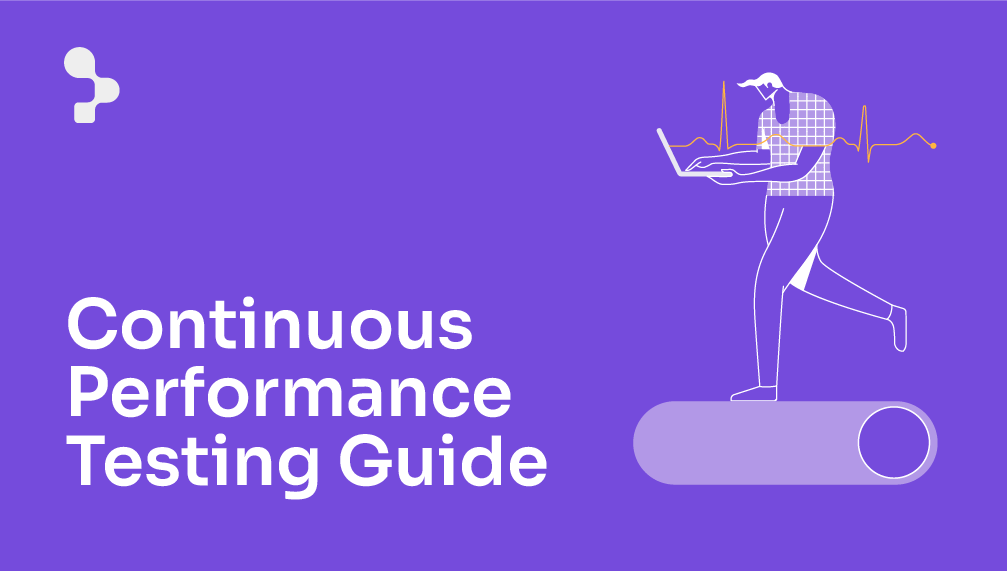Explore the essentials of Continuous Performance Testing and see how it revolutionizes software development. Learn to harness powerful tools for seamless integration and peak performance. Join us for insights on elevating your digital experience.

In today’s ever-evolving digital landscape, speed and efficiency aren’t just desired – they’re expected. In this context, Continuous Performance Testing (CPT) stands as a vital pulse, enabling digital platforms to remain robust and responsive. This guide unveils the layers of CPT, transforming not just how we test, but also how software thrives under real-world pressures.
Explore the meticulous craft of CPT with us—where every update is a step toward increasingly higher-quality software.
What is Continuous Performance Testing?
As stated by our CTO Roger Abelenda, System failures and inadequate performance in the face of high demand can have a major impact on retention and conversion rates, as well as the sustainability and scalability of companies.
Digital platforms are increasingly central to people’s lives in a globalized world that is almost completely interconnected. So, as you can see, losses can be really huge.
All kinds of failures may occur on different platforms and impact our lives.
For instance, we can mention Health platforms and impairing access to important medical information at the right time. Banking systems, in which affecting the completion of necessary transactions may result in in situations that cannot be postponed. Or simply delays on entertainment platforms, when someone wants to slow down and take a break after a long day’s work. The options are endless.
By conducting thorough performance testing, you can identify and resolve performance issues before they negatively impact your users’ experience. So, first and foremost, we recommend you read this article, in which we tell you why performance testing is the master key to improving your software.
We also invite you to listen to this episode of Quality Sense Podcast, with Federico Toledo and Leandro Melendez, to understand why performance testing should be part of your software development cycle.
Continuous Performance Testing is not just another buzzword in the tech community. At its core, it’s an evolution of the traditional performance testing methods.
How Does Continuous Performance Testing Differ From Regular Performance Testing?
While regular performance testing is typically conducted at certain stages of the software development life cycle, Continuous Performance Testing (CPT) is an ongoing process. It contributes to evaluating every change to the software for its performance implications, assisting in the goal of avoiding unexpected surprises down the road.
What are the differences between Functional and Non- Functional testing? In this article, we focus on their differences in order to achieve a thorough understanding of these issues.
Types of Performance Tests
As we already know at this point, performance testing is a broad field, with different types catering to various needs, which are crucial for identifying and rectifying issues.
- Load Testing: Assesses system capacity by simulating maximum usage with an analysis of users and operations to determine system capacity.
- Stress Testing: Identifies the system’s breaking point by gradually increasing user load until failure, showcasing maximum capacity and recovery times.
- Endurance Testing: Examines system performance over extended periods to detect issues like memory leaks and assess long-term behavior.
- Throttle Testing: Simulates slower network connections to analyze user response times under different network conditions.
- Peak Testing: Evaluates how the system responds to sudden user load spikes alongside regular usage, demonstrating recovery from peak loads.
- Scalability Testing: Examines how the system scales by adding additional resources, such as servers or CPU, to optimize performance and prevent issues for end users.
Interested in learning more about this topic? In this article, we delve into these various types of performance testing in a testing environment, highlighting their key differences.
Performance Testing Domains
Within the software development process and the broader software development lifecycle, performance testing plays a critical role in enhancing the optimization and efficiency of various aspects, such as web applications, mobile apps, APIs, and client-side interfaces.
Here, we explore different performance testing domains that contribute to these improvements throughout the development cycle.
- Web App Performance Testing: This enhances the responsiveness and efficiency of web applications.
- Mobile App Performance Testing: As mobile devices dominate the market, optimizing your app’s performance on these devices is crucial.
- API Performance Testing: This evaluates the efficiency and responsiveness of application interfaces.
- Client-side Performance Testing: The user interface serves as the initial point of interaction, and enhancing its performance is essential for a positive user experience.
Popular Performance Testing Tools
Performance testing reveals a system’s behavior under various conditions. While it may excel with 1,000 users, its response to 100,000 is uncertain. Therefore, in the quest for speed, scalability, and stability, consider using specialized tools to simulate high loads when testing how your site or app handles concurrent users.
Performance testing tools play a crucial role in predicting system capacities and enabling the delivery of high-quality software. Generally, they are divided into two main categories: open-source and proprietary.
Open-source offerings stand out due to their adaptability, community-driven updates, and absence of licensing costs. In contrast, proprietary solutions bring to the table unique, specialized features backed by comprehensive support, often tailored to address intricate testing scenarios.
When you’re on the hunt for the right performance testing tool, it’s all about understanding your needs. The charm of open-source lies in its flexibility and the collective innovation of its user community. Meanwhile, proprietary tools shine when you require sophisticated features with consistent, dedicated assistance.
Evaluating your project’s specific requirements, budget, and desired support level is the key to making an enlightened decision. Not only can it bring you reduced costs, but it can also impact your performance testing activities, enhancing your agile performance testing, continuous delivery, and overall quality.
Curious to know more about the top contenders in performance testing? Dive deeper by exploring our detailed insights and reviews here.
Click here and get to know our TOP 10 best Performance Testing Tools of 2023, including open-source platforms and proprietary testing tools.
What are The Benefits of Continuous Performance Testing?
Performance testing is a critical part of the software testing process. By integrating CPT into our workflow, we’ve observed that:
- We can identify and fix performance bottlenecks faster.
- Our software remains consistently efficient, offering a smoother experience for users.
- We build with confidence, knowing that each change won’t degrade the software’s performance.
You can keep learning about these benefits in this article.
Would you like to know a real example? Click here and get to know how Shutterfly masters continuous performance testing by “adjusting the belt tight.”
How to Start with CPT?
Embarking on the CPT journey might feel overwhelming, but with the right steps, it becomes a seamless part of the development process.
Best Time Start Performance Testing
When taking into account the performance of existing systems or ones built from scratch, teams have to determine at what point in the development process they are going to benefit most from running performance tests. Should we start performance testing early, at the beginning, alongside development (taking the agile performance testing approach), or at the end (the waterfall approach)?
The agile approach is when we start performance testing at the beginning of the development process and continue with it along with the whole evolution of the application. The waterfall approach is when we leave all the performance testing activities for the end of development, such as acceptance testing, and checking that the system performs as needed.
Can we definitively claim that one approach is better than the other in every instance? No. We need both approaches in different stages of our development cycle. We should start early by doing performance engineering and we also need to simulate load for acceptance testing. Read this article to get a deep understanding of this topic.
Apart from that, we must say that implementing Shift-Left Testing practices is fundamental to achieving early analysis of quality and creating better software. However, Shift-Right Testing offers other great advantages to improve testing strategies.
At Abstracta, we believe that Shift-Left testing and shift-right Testing is are possible strategies not only for continuous performance testing but also for all continuous testing, including Test Automation, Functional, Accessibility, Security, and DevOps. Continue learning in this article.
How to Make a Performance Test Plan
Planning a performance test plan is crucial for understanding your system’s capability to handle various levels of stress and load. It’s about crafting a strategy to understand your system’s performance under various scenarios with minimal test runs.
Key Steps in Your Performance Test Plan:
- Identify Your Goals: What do you need to know? This could be the system’s behavior under stress, typical load, prolonged operation, or unexpected traffic spikes.
- Start Small and Scale: Begin with a baseline test using a reduced number of users, then incrementally increase the load, resolving any issues along the way.
- Customize Your Approach: Depending on whether you’re running stress, load, endurance, or peak tests, adjust the user numbers to explore different performance thresholds.
- Iterate and Refine: Use iterative testing to build upon previous results, refining your strategy based on the data collected.
- Analyze and Adapt: Keep an eye on how the system scales and recovers from each test, making adjustments to improve performance and stability.
Your performance test plan should not only be methodical but also adaptable. The incremental and iterative approach ensures you’re actively learning and enhancing your system’s performance. Read this article for an in-depth guide on how to create a test plan!
Performance Testing Metrics
Unlocking the full potential of performance testing means delving into the performance metrics that matter. It’s not enough to run tests and gather data; the real power lies in accurate analysis, empowering you to make informed decisions and boost your system’s performance.
To guide you on this journey, here are some essential tips:
- Grasp the Basics: Understand the significance of these main metrics: average response time, standard deviation, and percentiles. They give you data about different aspects of performance but require careful interpretation to avoid misleading conclusions.
- Average Response Time: Recognize an average can mask extremes—it’s a starting point but doesn’t fully represent individual system experiences.
- Standard Deviation: This metric tells you about the spread of your data around the average. A small standard deviation means consistent performance, while a large one indicates variability that needs attention.
- Percentiles: These are your reality check, showing you how the majority of your samples perform. Setting SLAs based on percentiles can ensure that the majority of user experiences meet your performance criteria.
- Visualize with Graphs: Data sets can be deceptive when viewed in isolation. Graphs offer a clearer picture, revealing trends and anomalies that raw numbers might hide, hence the importance of graphical analysis.
- Contextualize Metrics for Real-World Relevance: It’s vital to align your metrics with real-world usage scenarios. Consider how users interact with your system during peak times, regular operations, and uncommon but critical events. Correlating metrics with actual user behavior patterns helps prioritize improvements that impact the user experience.
All in all, don’t be misled by averages, pay attention to the spread of your data with standard deviation, and set realistic criteria based on percentiles. With these tools in hand, you’re better equipped to refine your system’s performance. Explore this article for a deeper dive!
We also recommend you click here to learn what is throughput in performance testing and how it is calculated.
Automated Continuous Performance Testing
Automating the process enhances performance tests to be run consistently and frequently by handling the repetitive tasks that traditionally demanded manual and continuous effort.
Integral to this approach is its seamless integration into the development lifecycle, which allows for early identification and remediation of performance bottlenecks. By catching issues as they emerge, automated continuous performance testing not only optimizes the system but also aligns performance goals closely with the development progression.
Yet, the reliance on automated continuous performance testing doesn’t overshadow the importance of traditional testing methods. For substantial updates or releases that carry the weight of significant changes, a conventional approach to software testing remains essential.
These instances require a nuanced evaluation to ensure new or modified features perform as intended without introducing unforeseen issues, with a keen eye on the specific nuances of each update and the expected outcomes.
How to Integrate Performance Tests Into CI/CD Pipeline?
Integrating performance tests into your CI/CD pipeline with tools such as JMeter DSL, Jenkins, Travis CI, or CircleCI means each code commit triggers an automatic performance assessment.
- Define Testing Focus: Determine which functionalities need testing, the data required, and the specific scenarios to run.
- Choose the Right Tools: Opt for tools that meet your project’s needs and are easy for your team to adopt.
- Automate and Integrate: Progress to test automation and integrate these into the pipeline. Be prepared for an iterative process, making adjustments to continuously align with your business goals and deliver value.
This proactive approach enables you to refine your strategy over time, enabling your performance testing to be both efficient and effective, ultimately adding significant value to your product.
Challenges of Continuous Performance Testing
Like any journey, the path to CPT is not without its challenges. Sometimes, the sheer volume of tests can be overwhelming, posing a significant challenge in managing and prioritizing them. How do you strike the right balance? Too many tests can lead to inefficiency, while too few might leave gaps in your coverage. Being able to find that sweet spot is key.
At other times, false positives can be a roadblock, causing unnecessary alarm and wasting precious time as teams scramble to address issues that don’t actually exist. It’s crucial to fine-tune your test parameters and thresholds to minimize these occurrences.
The constant evolution of software adds complexity to CPT as well. As new features roll out and changes are implemented, tests must adapt quickly. This continuous iteration requires a robust strategy that accommodates frequent updates without compromising the integrity of the testing process.
Integrating CPT into the existing CI/CD pipeline also requires careful planning. It’s not just about adding tests; it’s about making it possible that they complement and enhance the workflow without causing bottlenecks or disruptions.
In essence, while CPT comes with its share of hurdles, they’re all part of the process. By staying vigilant and adaptable, these challenges can be navigated successfully, leading to a more resilient and performance-optimized product.
Additionally, in continuous performance testing, evolving challenges like robust test monitoring, user experience management, API security, and WebSocket testing are critical to addressing for maintaining software excellence in rapid development cycles. Keep learning in this article.
Best Practices for Continuous Performance Testing
Implementing robust continuous performance testing practices is crucial for maintaining software quality in the fast-paced realm of CI/CD. Here are some of the best practices that have emerged as pillars for streamlining performance:
- Synthetic Load Generation: Injecting synthetic traffic to model and prepare for potential future demands, aiming to prepare systems for peak usage scenarios like sales or new releases.
- Resiliency Testing: Applying chaos engineering to enhance system resilience, enabling it to withstand unexpected conditions.
- Performance Script Versioning: Aligning test scripts with application codebase versions to streamline change management and encourage collaborative problem-solving.
- Performance Testing Pyramid: Adopt a structured approach to prioritize tests. Start with unit tests for quick feedback, proceed to service tests for more complex interactions, and conclude with end-to-end tests to enable overall system integrity.
- Isolated and Integrated Component Testing: Testing services individually and in unison to enable seamless interaction and performance within the system’s architecture.
- Environment Reproducibility: Crafting test environments that are consistent and repeatable, enhancing the reliability of performance testing outcomes.
- User-Friendly Reporting: Creating clear, actionable reports that facilitate quick analysis and informed decision-making on performance metrics.
- Cross-Environment Analysis: Evaluating performance across various platforms to streamline user experience, regardless of the device or network conditions.
- Observability: Integrating observability tools and practices to gain deeper insights into system performance and to enable real-time monitoring and troubleshooting.
Each of these practices contributes to a robust framework that not only identifies performance issues but also enhances the overall quality of the software. We invite you to read an in-depth discussion about best practices in this article.
Now, Harness the Power of Continuous Performance Testing!
Continuous Performance Testing is not just a methodology; it’s a commitment to excellence. And as we’ve found, with the right approach and tools, it’s a commitment that reaps significant rewards.
We hope this guide sets you on a successful path to integrating continuous performance testing into your projects.
Embrace these practices, and you’ll be well on your way to making a positive impact in the software industry and society at large. Unlock optimal software performance and improve user experience with proactive performance testing!
Visit our Performance Testing Services page and contact us to discuss how we can help you grow your business.
Tags In
Related Posts
An End-to-End Guide of Load Testing
From planning to analysis and reporting, here’s what to know before you run your first load test If you have a public-facing web application, the odds are you should probably be thinking about load testing. Any tester can (and should) add load testing to their…
What’s More Important: The Performance Testing Tool or the Tester?
What should we be more cautious about choosing: the tool we use or the person to run performance tests? Does the tool or the tester matter more for a good performance test? An aspect we always stress in performance testing is that the tools are…
Search
Contents




 Abstracta
Abstracta
